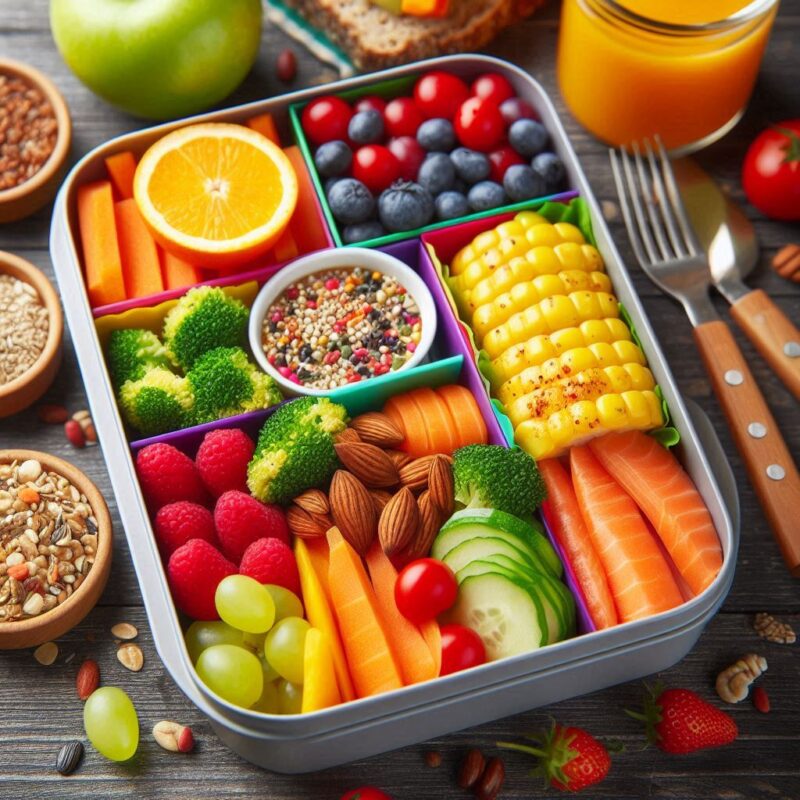Meal Plans
Fiber-Rich Lunches for Sustained Energy

Fiber-Rich Lunches for Sustained Energy focus on meals that provide lasting fullness and energy throughout the day. Fiber is an essential nutrient that supports digestive health, regulates blood sugar levels, and promotes a feeling of fullness, which can help with weight management. Incorporating fiber-rich foods into your lunches can lead to sustained energy, improved concentration, and better overall health.
The Importance of Fiber:
- Digestive Health: Fiber aids in digestion by promoting regular bowel movements and preventing constipation. It can also help maintain a healthy gut microbiome.
- Sustained Energy: High-fiber foods digest more slowly, leading to gradual increases in blood sugar and preventing energy crashes that often follow meals high in refined carbohydrates.
- Weight Management: Foods rich in fiber tend to be more filling, which can help curb hunger and reduce overall calorie intake.
- Heart Health: Soluble fiber can help lower cholesterol levels, reducing the risk of heart disease.
Sources of Fiber-Rich Foods:
- Fruits: Berries, apples, pears, bananas, oranges
- Vegetables: Broccoli, carrots, Brussels sprouts, leafy greens, sweet potatoes
- Legumes: Lentils, chickpeas, black beans, kidney beans
- Whole Grains: Quinoa, brown rice, oats, whole wheat bread, barley
- Nuts and Seeds: Almonds, chia seeds, flaxseeds, walnuts
Sample Fiber-Rich Lunch Ideas:
- Quinoa Salad with Black Beans and Avocado:
- Ingredients: Cooked quinoa, canned black beans (rinsed), diced avocado, cherry tomatoes, corn, lime juice, cilantro, and spices.
- Benefits: Quinoa and black beans provide protein and fiber, while avocado adds healthy fats, promoting satiety.
- Chickpea and Spinach Wrap:
- Ingredients: Whole wheat wrap, mashed chickpeas, fresh spinach, shredded carrots, cucumbers, and a yogurt-based dressing or hummus.
- Benefits: Chickpeas are high in fiber and protein, while the wrap includes additional fiber from whole grains and vegetables.
- Lentil Soup with Whole Grain Bread:
- Ingredients: Lentils, diced tomatoes, carrots, celery, onions, garlic, vegetable broth, and spices; served with a slice of whole-grain bread.
- Benefits: Lentils are packed with fiber and protein, while the soup keeps you warm and satisfied. The whole grain bread adds extra fiber.
- Vegetable Stir-Fry with Brown Rice:
- Ingredients: Mixed vegetables (broccoli, bell peppers, snap peas), tofu or chicken, soy sauce, ginger, and brown rice.
- Benefits: Brown rice is a whole grain with more fiber than white rice, and the variety of vegetables increases fiber content.
- Overnight Oats with Berries and Chia Seeds:
- Ingredients: Rolled oats, chia seeds, almond milk, and mixed berries (strawberries, blueberries, raspberries).
- Benefits: Oats and chia seeds provide soluble and insoluble fiber, promoting digestive health and keeping you full.
- Sweet Potato and Black Bean Bowl:
- Ingredients: Roasted sweet potatoes, black beans, diced tomatoes, avocado, and a drizzle of lime vinaigrette.
- Benefits: Sweet potatoes are a great source of fiber and antioxidants, while black beans add additional protein and fiber.
- Greek Yogurt Parfait:
- Ingredients: Greek yogurt, layered with mixed berries, a handful of granola (preferably high-fiber), and a sprinkle of flaxseeds or chia seeds.
- Benefits: Greek yogurt provides protein, while the berries and seeds add fiber, creating a balanced and filling lunch.
Tips for Incorporating More Fiber into Your Lunches:
- Plan Ahead: Preparing meals in advance can help you ensure you’re incorporating fiber-rich foods. Make batch salads, soups, or grain bowls for easy grab-and-go lunches.
- Experiment with Whole Grains: Substitute refined grains for whole grains in your recipes. Use brown rice instead of white rice, whole wheat pasta instead of regular pasta, and quinoa in salads and bowls.
- Add Legumes: Incorporate beans, lentils, or chickpeas into salads, wraps, and soups. They are excellent sources of fiber and can boost protein content.
- Snack on Fruits and Vegetables: Include a piece of fruit or raw vegetables with hummus as a snack alongside your lunch to increase fiber intake.
- Mix and Match: Combine different fiber sources in your lunches to enhance variety and maximize nutrient intake.
Conclusion:
Incorporating fiber-rich foods into your lunches not only supports digestive health but also provides sustained energy throughout the day. By planning meals that include whole grains, legumes, fruits, and vegetables, you can create delicious, satisfying lunches that keep you feeling full and focused. Remember, the key to a healthy diet is balance and variety, so try new recipes and enjoy the journey toward better health!
Would you like more specific recipes or tips on meal prep?